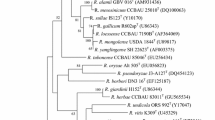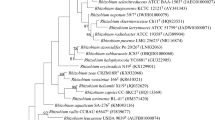Abstract
A strain 5-1-2T was isolated from a root nodule of Hedysarum multijugum collected from Zhangye city, Gansu province, north-west China. Phylogenetic analysis based on the 16S rRNA gene sequence and other housekeeping genes (recA and atpD) indicated that the strain represents a novel species in the genus Rhizobium close to the strain Rhizobium subbaraonis JC85T with similarities of 98.27, 88.92 and 89.62%, respectively. Strain 5-1-2T contained Q-10 as the predominant ubiquinone. Our results showed that the major fatty acids were feature 8 (C18:1 ω7c and/or C18:1 ω6c; 38.90%). In addition, the DNA–DNA hybridizations with the type strains R. subbaraonis JC85T and Rhizobium halophytocola YC6881T were 39.2 ± 2.1 and 44.3 ± 1.9, respectively. Therefore, a novel species Rhizobium hedysari sp. nov. is proposed, and 5-1-2T (=CGMCC1.15677T = NBRC112532T) is designated as the type strain.





Similar content being viewed by others
References
Altschul SF, Gish W, Miller W, Myers EW, Lipman DJ (1990) Basic local alignment search tool. J Mol Biol 215:403–410
Beringer JE (1974) R factor transfer in Rhizobium leguminosarum. J Gen Microbiol 84:188–198
Chen DZ (1999) Flora reipublicae popularis sinicae, vol 42. Science Press, Beijing
Chen W, Sheng XF, He LY, Huang Z (2015) Rhizobium yantingense sp. nov, a mineral-weathering bacterium. Int J Syst Evol Microbiol 65:412–417
Dazzo FB (1982) Leguminous root nodules. In: Burns R, Slater J (eds) Experimental microbial ecology. Blackwell Scientific Publications, Oxford
De Ley J, Cattoir H, Reynaerts A (1970) The quantitative measurement of DNA hybridization from renaturation rates. Eur J Biochem 12:133–142
Elliott GN, Chen WM, Bontemps C, Chou JH, Young JPW, Sprent JI, James EK (2007) Nodulation of Cyclopia spp. (Leguminosae, Papilionoideae) by Burkholderia tuberum. Ann Bot 100:1403–1411
Felsenstein J (1985) Confidence limits on phylogenies: an approach using the bootstrap. Evolution 39:783–791
Fitch WM (1971) Toward defining the course of evolution: minimum change for a specific tree topology. Syst Zool 20:406–416
Galtier N, Gouy M, Gautier C (1996) SEAVIEW and PHYLO_WIN: two graphic tools for sequence alignment and molecular phylogeny. Comput Appl Biosci 12:543–548
Gao JL, Sun JG, Li Y, Wang ET, Chen WX (1994) Numerical taxonomy and DNA relatedness of tropical rhizobia isolated from Hainan Province, China. Int J Syst Bacteriol 44:151–158
Gaunt MW, Turner SL, Rigottier-Gois L, Lloyd-Macgilp SA, Young JPW (2001) Phylogenies of atpD and recA support the small subunit rRNA-based classification of rhizobia. Int J Syst Evol Microbiol 51:2037–2048
Graham PH, Sadowsky MJ, Keyser HH, Barnet YM, Bradley RS, Cooper JE, De Ley DJ, Jarvis BDW, Roslycky EB (1991) Proposed minimal standards for the description of new genera and species of root- and stem-nodulating bacteria. Int J Syst Bacteriol 41:582–587
Jiao YS, Yan H, Ji ZJ, Liu YH, Sui XH, Wang ET, Guo BL, Chen WX, Chen WF (2015) Rhizobium sophorae sp. nov. and Rhizobium sophoriradicis sp. nov., nitrogen-fixing rhizobial symbionts of the medicinal legume Sophora flavescens. Int J Syst Evol Microbiol 65:497–503
Kim OS, Cho YJ, Lee K, Yoon SH, Kim M, Na H, Park SC, Jeon YS, Lee JH, Yi H, Won S, Chun J (2012) Introducing EzTaxon-e: a prokaryotic 16S rRNA gene sequence data- base with phylotypes that represent uncultured species. Int J Syst Evol Microbiol 62:716–721
Kuklinsky-Sobral J, Araujo WL, Mendes R, Geraldi IO, Pizzirani-Kleiner AA, Azevedo JL (2004) Isolation and characterization of soybean-associated bacteria and their potential for plantgrowth promotion. Environ Microbiol 6:1244–1251
Laguerre G, Nour SM, Macheret V, Sanjuan J, Drouin P, Amarger N (2001) Classification of rhizobia based on nodC and nifH gene analysis reveals a close phylogenetic relationship among Phaseolus vulgaris symbionts. Microbiology 147:981–993
Lin SY, Hung MH, Hameed A, Liu YC, Hsu YH, Wen CZ, Arun AB, Busse HJ, Glaeser SP (2015) Rhizobium capsici sp. nov., isolated from root tumor of a green bell pepper (Capsicum annuum var. grossum) plant. Antonie Van Leeuwenhoek 107:773–784
Liu Y, Yang JS (2005) Studies on chemical constituents isolated from Hedysarum polybotrys. Chin Pharm J 40:1215–1216
Liu Y, Zhang QY, Zhao YY, Wang B, Hai LQ, Ying YP, Chen HB (2007) Saponins from the roots of Hedysarum polybotrys. Biochem Syst Ecol 35:389–391
Marmur J, Doty P (1962) Determination of the base composition of 171 deoxyribonucleic acid from its thermal denaturation temperature. J Mol Biol 5:109–118
Nechepurenko IV, Polovinka MP, Komarova NI, Korchagina DV, Salakhutdinov NF, Nechepurenko SB (2008) Low-molecular-weight phenolic compounds from Hedysarum theinum roots. Chem Nat Compd 44:31–34
Rashid MH, Young JPW, Everall I, Clercx P, Willems A, Santhosh Braun M, Wink M (2015) Average nucleotide identity of genome sequences supports the description of Rhizobium lentis sp. nov., Rhizobium bangladeshense sp. nov. and Rhizobium binae sp. nov. from lentil (Lens culinaris) nodules. Int J Syst Evol Microbiol 65:3037–3045
Ribeiro RA, Martins TB, Ormen̋o-orrillo E, Marcon Delamuta JR, Rogel MA, Martinez-Romero E, Hungria M (2015) Rhizobium ecuadorense sp. nov., an indigenous N2-fixing symbiont of the Ecuadorian common bean (Phaseolus vulgaris L.) genetic pool. Int J Syst Evol Microbiol 65:3162–3169
Roman-Ponce B, Zhang YJ, Vasquez-murrieta MS, Sui XH, Chen WF, Alberto Padilla JC, Guo XW, Gao JL, Yan J, Wei GH, Wang ET (2016) Rhizobium acidisoli sp. nov., isolated from root nodules of Phaseolus vulgaris in acid soils. Int J Syst Evol Microbiol 66:398–406
Saitou N, Nei M (1987) The neighbor-joining method: a new method for reconstructing phylogenetic trees. Mol Biol Evol 4:406–425
Sasser M (1990) Identification of bacteria by gas chromatography of cellular fatty acids, MIDI technical note 101. MIDI Inc, Newark
Terefework Z, Kaijalainen S, Lindström K (2001) AFLP fingerprinting as a tool to study the genetic diversity of Rhizobium galegae. J Biotechnol 91:169–180
Thompson JD, Higgins DG, Gibson TJ (1994) CLUSTAL W: improving the sensitivity of progressive multiple sequence alignment through sequence weighting, position-specific gap penalties and weight matrix choice. Nucl Acids Res 22:4673–4680
Tighe SW, de Lajudie P, Dipietro K, Lindström K, Nick G, Jarvis BD (2000) Analysis of cellular fatty acids and phenotypic relationships of Agrobacterium, Bradyrhizobium, Mesorhizobium, Rhizobium and Ensifer species using the Sherlock Microbial Identification System. Int J Syst Evol Microbiol 50:787–801
Turner SL, Young JPW (2000) The glutamine synthetases of rhizobia: phylogenetics and evolutionary implications. Mol Biol Evol 17:309–319
Vincent JM (1970) A manual for the practical study of root nodule bacteria. Blackwell Scientific Publication, Oxford
Xu L, Zhang Y, Deng ZS, Zhao L, Wei XL, Wei GH (2013) Rhizobium qilianshanense sp. nov., a novel species isolated from root nodule of Oxytropis ochrocephala Bunge in China. Antonie Van Leeuwenhoek 103:559–565
Young JM, Kuykendall LD, Martınez-Romero E, Kerr A, Sawada H et al (2001) A revision of Rhizobium Frank 1889, with an emended description of the genus, and the inclusion of all species of Agrobacterium Conn 1942 and Allorhizobium undicola de Lajudie 1998 as new combinations: Rhizobium radiobacter, R. rhizogenes, R. rubi, R. undicola and R. vitis. Int J Syst Evol Microbiol 51:89–103
Zehr JP, Jenkins BD, Short SM, Steward GF (2003) Nitrogenase gene diversity and microbial community structure: a crosssystem comparison. Environ Microbiol 5:539–554
Acknowledgements
This work was supported by projects from National Science Foundation of China (31360004), China Scholarship Council fund and Education Department of Gansu Province (2014A-107). We would like to express our gratitude to Professor Shuangjiang Liu and Chengying Jiang (Institute of Microbiology, Chinese Academy of Sciences, Beijing, China) for providing the type strains. Also we are grateful to professor J Peter W Young, Dr. Yong Zhang and Dr. Osama Abdalla Mohamad for revising our manuscript.
Author information
Authors and Affiliations
Corresponding author
Electronic supplementary material
Below is the link to the electronic supplementary material.
Rights and permissions
About this article
Cite this article
Xu, L., Shi, J., Li, C. et al. Rhizobium hedysari sp. nov., a novel species isolated from a root nodule of Hedysarum multijugum in China. Antonie van Leeuwenhoek 110, 479–488 (2017). https://doi.org/10.1007/s10482-016-0817-z
Received:
Accepted:
Published:
Issue Date:
DOI: https://doi.org/10.1007/s10482-016-0817-z




